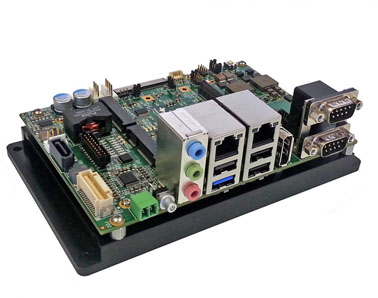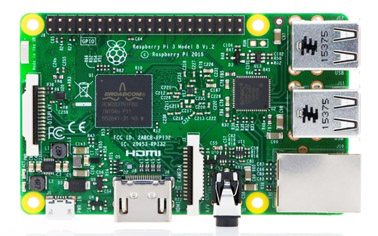When did it start? I forget. When did we start getting all these wonderful low-cost single-board computers? Raspberry Pi wasn’t the first one available — was it?
In any case, we have a lot of choices now and I’ve chosen five of the newest for an overview of the sector. They vary from $499 to $10 each. All of these boards may be purchased in volume and/or have complete component and layout information readily available. All but one have an Ethernet port or WiFi — making them IoT-ready.
WinSystems
WinSystems offers the SBC35-CC405 Atom E3800-based embedded computers that operate from −40°C to +85°C and come in an industry-standard 3.5-inch COM Express carrier format. The embedded PC includes USB, Gigabit Ethernet, serial ports, and I/O expansion through MiniPCIe and IO60 connectors. The board's processor is a Type 6 COM Express module supporting quad-core, dual-core, or single-core versions and includes up to 8 Gbytes of DDR3L.

The CPU's graphics engine supports two simultaneous displays with interfaces for analog VGA, DisplayPort 1.1, and LVDS. For networking and communications, the board includes two Intel I210 Gigabit Ethernet controllers with IEEE 1588 time-stamping. There are four Type-A connectors that support three USB 2.0 channels and one USB 3.0 channel. The single-core E3815-based SBC35-CC405-3815-2-2 version with 2 Gbytes of DDR3 is priced as low as $499 in OEM quantities.
Intel Edison
The Intel Edison is an ultra-small computing platform that Intel says might change the way you look at embedded electronics. Each Edison packs a large amount of tech goodies into a 1.4 × 1.0 × 0.15-in. package with the same robust performance of a larger single-board computer. Edison has a 70-pin connector to attach a veritable slew of shield-like “blocks,” which can be stacked on top of each other.

The card is powered by a 22-nm SoC that has a dual-core dual-threaded 500 Mhz Atom CPU, and a super low-power 32-bit 100-MHz Quark microcontroller, 1 Gbyte of 800-MHz LPDDR3 POP memory, 4 Gbytes of eMMC flash, dual-band WiFi via a Broadcom 43340 802.11 (with antenna), and Bluetooth 4.0. It runs on 3.3 to 4.5 V at less than 1 W, and standby takes only 13 mW (21.5 mW with Bluetooth). The board has six analog inputs, a UART, I2 C, and USB 2.0, and supports SD flash cards. With extremely low-power, low-level processing and available high performance, Edison is great for many IoT applications. It costs just $50.
The Intel Edison Breakout Board is also available. It is just slightly larger than the Edison module. It exposes native 1.8-V I/O of the module and has 0.1-in. grid I/O array of solder points for customizing, along with USB OTG with a Micro Type-AB connector, a battery charger, and a DC power supply jack (7- to 15-VDC input).
Raspberry Pi 3 Model B
The latest Raspberry Pi features a Broadcom BCM2837 64-bit quad core processor running at 1.2 GHz and it has another Broadcom chip providing WiFi and Bluetooth LE wireless. The board has 1 Gbyte of 400 MHZ RAM, a 10/100 Ethernet port, a 40-pin extended GPIO, four USB 2 ports, a stereo output, and composite video port.

It also has a full-sized HDMI I/O, a CSI camera port, a DSI display port for connecting a touchscreen display, and a Micro SD port. The card has an upgraded switched Micro USB power source supporting up to 2.4 Amps. It does take more basic power than previous models — 2.5 A at 5 V. The model B costs $35 and is in stock at a few sales outlets.
Texas Instruments
The Texas Instruments LaunchPad TM4C Secure IoT Gateway Platform (EK-TM4C129EXL) features TM4C129E microcontroller with hardware encryption accelerators for data protection in connected applications. It features on-board emulation, which means a developer can program and debug IoT gateway projects without the need for additional hardware tools.
The TM4C includes everything you need to get started with ARM Cortex-M4F IoT application development, including a 49 x 2 breadboard connector and retractable Ethernet cable. It features hardware crypto accelerators with AES, Data Encryption Standard (DES), Secure Hash Algorithm (SHA), and Cyclic Redundancy Check (CRC) accelerators to increase performance in secure connected applications.

The package has a secured cloud connection demonstration with TI RTOS, WolfSSL and Exosite. The platform's TM4C129E 120 MHz Cortex-M4 processor has 1 Mbyte of flash, 256 Kbytes of SRAM, a 6-Kbyte EEPROM and an integrated 10/100 Ethernet MAC+PHY. It also has on-chip data protection and an LCD controller.
Interfaces include 10 I2 C, eight UART, four Quad-SSI, and two CAN, plus USB 2.0 and the Ethernet mentioned earlier. There are dual 12-bit 2-Ms/s A/D converters, three analog comparators, and 16 digital comparators, plus a PWM module.
The price of the LaunchPad TM4C is just $25. An engineer can add two stackable BoosterPack XL 40-pin interfaces that add support for displays, wireless interfaces, sensors, and other capabilities.
Cypress
The CY8CKIT-049-42xx is a PSoC 4 prototyping kit based on the PSoC 4200 family of programmable SoCs. The kit includes a CY7C65211 full-speed USB controller used to bootload the target PSoC device and connect to peripherals. The CY8C42xx SoC has a 48-MHz Cortex-M0 processor and programmable analog and digital blocks with flexible routing and interconnects. It includes up to 128 Kbytes of flash, 16 Kbytes of SRAM, and two CAN ports.

Programmable analog blocks in the SoC include two low-power comparators, four op-amps, a 12-bit, 1 Ms/s SAR A/D converter, four IDACs (2x 8-bit, 2x 7-bit), and one 55-channel analog multiplexer. The chip has four programmable digital blocks and four universal digital blocks. This kit also features a footprint for the EZ-BLE PRoC Module, enabling users to add Bluetooth LE. This kit is the only one here without an Ethernet port.
The CY7C65211 IC integrates CapSense touch control with SmartSense auto-tuning and USB battery-charging power. The prototyping board is breakable, allowing the user to separate the USB to Serial board from the PSoC 4 board. This kit supports either 5- or 3.3-V power supply voltages. It also has Cypress KitProg, designed to program and debug the target device using the SWD interface. The kit costs only $10.
Advertisement
Learn more about Cypress SemiconductorIntelTexas InstrumentsWinSystems





